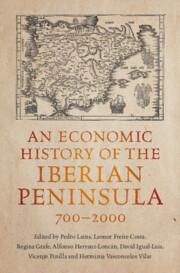Book contents
- An Economic History of the Iberian Peninsula, 700–2000
- An Economic History of the Iberian Peninsula, 700–2000
- Copyright page
- Contents
- Figures
- Tables
- Contributors
- Preface: By Way of Presentation
- Introduction
- Part I The Making of Iberia, 700–1500
- Section I The Early Middle Ages, 700–1200
- 1 Muslim and Christian Polities, 700–1200
- Section II The Medieval Economy, 1000–1500
- Part II Globalization and Enlightenment, 1500–1800
- Part III Industrialization and Catching Up, 1800–2000
- References
- Index
1 - Muslim and Christian Polities, 700–1200
from Section I - The Early Middle Ages, 700–1200
Published online by Cambridge University Press: 22 February 2024
- An Economic History of the Iberian Peninsula, 700–2000
- An Economic History of the Iberian Peninsula, 700–2000
- Copyright page
- Contents
- Figures
- Tables
- Contributors
- Preface: By Way of Presentation
- Introduction
- Part I The Making of Iberia, 700–1500
- Section I The Early Middle Ages, 700–1200
- 1 Muslim and Christian Polities, 700–1200
- Section II The Medieval Economy, 1000–1500
- Part II Globalization and Enlightenment, 1500–1800
- Part III Industrialization and Catching Up, 1800–2000
- References
- Index
Summary
The long evolution that had been transforming the Iberian economy since the fifth century found its excipient in the Islamic invasion at the beginning of the eighth century. A consequence was the division of the peninsula into two parts separated by a territorial strip as a border. In the south side, the Muslim al-Andalus settled new population, generally repeating its tribal and traditional structure; applied changes in the tenure and exploitation of agricultural systems; and consolidated the preeminence of urban centres. On this basis it was established a monetary economy connected to the political and social evolution of Mediterranean Islam, applying economic policies that involved public expenditure, taxation and market regulation. Meanwhile, in the northern side, the Christian kingdoms and counties were strengthened thanks to the increase of agrarian land, including the absorption of the border strip. From the eleventh century onwards, feudal structures favoured the kingdoms and counties expansion over the Muslim south. Urban capitals articulated the new territories, at the same time that the Camino de Santiago attracted European immigration which promoted urban activities. Commercial development linked to centres beyond the Pyrenees and, through the Mediterranean, to urban centres of Provence and Italy.
Keywords
- Type
- Chapter
- Information
- An Economic History of the Iberian Peninsula, 700–2000 , pp. 25 - 46Publisher: Cambridge University PressPrint publication year: 2024

